Why does the onion turn yellow in the garden and what to do, how to water and feed, how to fight?
Failure to comply with agrotechnical techniques and ignoring preventive measures becomes the main reason why onions can turn yellow. There is either complete or partial yellowing of the leaves. However, they look lethargic, weakened. The situation could threaten the complete loss of the onion crop.
Content
- 1 Insufficient nitrogen content in the soil
- 2 Influence of pests
- 3 Why is onion moth dangerous?
- 4 Onion thrips
- 5 Onion fly and how to destroy it
- 6 Stem nematode
- 7 Weevil lurker and the fight against it
- 8 What is onion sick with?
- 9 Insufficient or improper watering
- 10 Lack of feeding
- 11 What to do?
- 12 Simple tips for onion care
Insufficient nitrogen content in the soil
A common reason why onions turn yellow is a lack of nitrogen in the soil. Its deficiency usually develops when the soil is depleted or in hot weather. Onion roots receive nitrogen only in dissolved form, and in dry weather it ceases to flow to plants. Conversely, excessive soil moisture or frequent rains can lead to the leaching of nutrients from the soil.
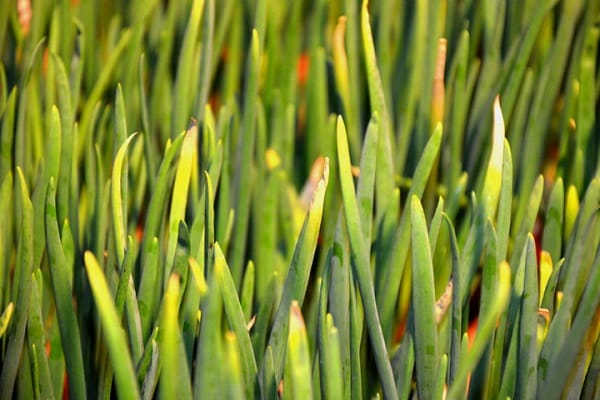
With a lack of nitrogen in the soil, the plant slows down its growth, the feathers become short and thick. At first, the color of the lower leaves turns pale green, and then the young feathers turn completely yellow. Lack of nitrogen can also lead to bottom rot.
In order to prevent a lack of nutrients in the soil, it is necessary to carry out top dressing in a timely manner. A solution based on urea or ammonium nitrate and manure infusion is well suited. The components must be dissolved in water so as not to burn the roots. The procedure can be repeated after 5-6 days.
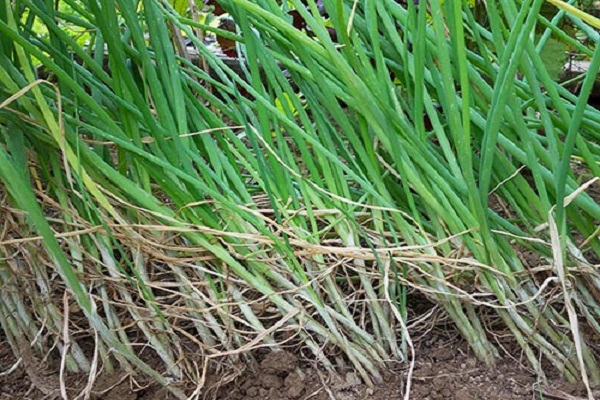
Influence of pests
Onions often turn yellow as a result of pest attacks. They not only suck the juices from the plant and gnaw at greens and roots, but also carry various infectious diseases.

Why is onion moth dangerous?
The onion moth is a small butterfly (body length about 8 mm), dark brown in color with light gray wings. In late spring, females begin to lay eggs at night near the bulbs or between the leaves. After 7–8 days, yellow-green caterpillars appear from the eggs, the length of which is 1 cm.
Great harm from insects is observed, especially in dry, hot weather. The leaves begin to turn yellow and dry at the tips, light spots may appear.
What to do if onions turn yellow in the beds due to the activity of onion moths? Effective is the action of drugs such as Iskra, Dachnik, Metaphos. To scare off pests helps to cultivate the land with wood ash, tobacco dust. Sevok should be sown as early as possible.It is recommended to remove all plant residues from the site in the fall and dig up the ground before the onset of frost.
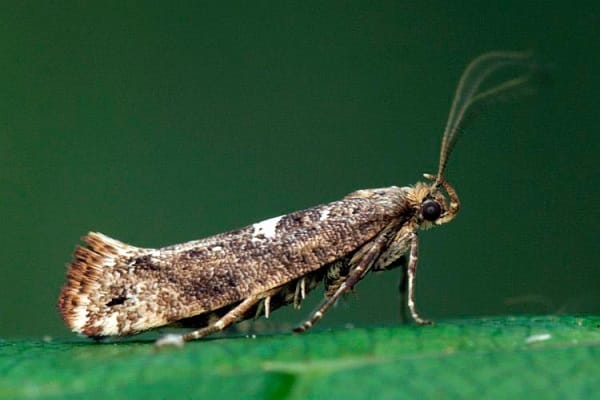
Onion thrips
Onion thrips is a small yellowish insect, its length is about 1 mm. It sucks the juices out of the plant, as a result of which the onion feathers turn yellow and dry out. The female lays eggs in the leaves, of which gray-yellow-green larvae appear in 5-6 days.
Thrips, like the onion moth, hibernate in the soil, burrowing into the remains of vegetation or in the bulbs that are intended for sowing. Therefore, a preventive measure is the autumn digging of the site with the introduction of fertilizers and cleaning of the remaining tops. Before planting, the sevok must be disinfected by placing, for example, in a weak solution of potassium permanganate or immersed in hot water (water temperature about 45 degrees) for 10 minutes. If a pest is found in the garden, they are treated with insecticides (Iskra, Confidor).
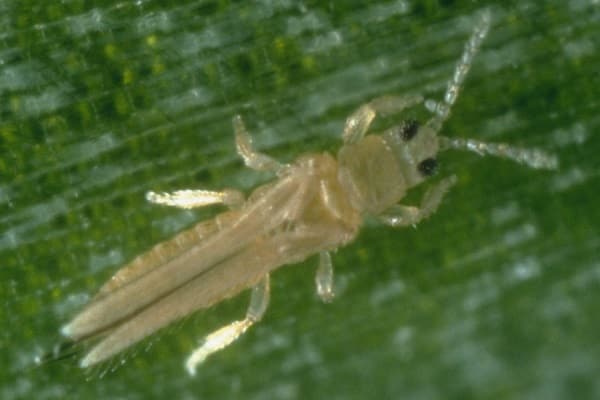
Onion fly and how to destroy it
The most common pest of onions is onion flythat affects any of its varieties. It resembles an ordinary fly, the body length reaches 8 mm, the color is gray-yellow.
In mid-May, when the dandelion and lilacs begin to bloom, the female of this insect begins to lay eggs in the soil near the onion beds, less often between young leaves or between the dry scales of the bulb. After 6 days, the larvae emerging from the eggs begin to eat the bulb from the bottom. Feathers begin to become covered with yellow spots, and soon the whole plant dies.
The larvae develop within three weeks. Then they burrow into the ground and pupate. After a while, new individuals appear, around the end of July.
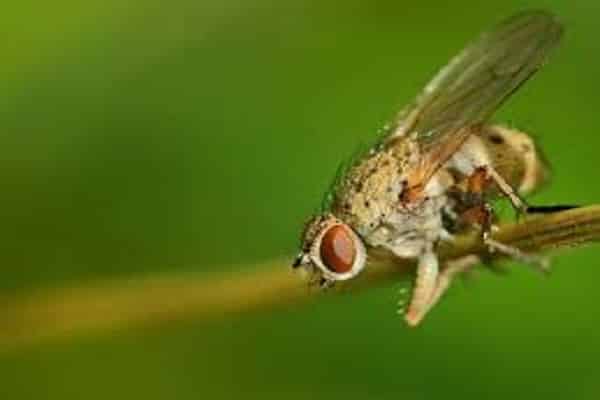
Preventive measures are:
- early planting of onions;
- it is recommended to plant carrots in the neighborhood;
- during the summer, the flies of the beds are treated with a mixture of wood ash, tobacco dust and ground pepper;
- the drug Bazudin helps to scare away insects, which is mixed with sand and added to the soil.
If the larvae have already begun their destructive activity, treatment with Kreocid, Mukhoed, Aktara, Karate Zeon will help. Treatment of onions with a saline solution with a few drops of ammonia turns out to be effective (200 g of salt must be dissolved in 10 liters of water).

Stem nematode
Stem nematodes, like onion flies, lead to yellowing of the leaves and loss of yield. The nematoda resembles a small worm (1.5 mm in length) that penetrates the bottom of the onion. Insects feed on plant sap. The bulb begins to rot. White dots and stripes appear on the feathers, then the onion leaves turn yellow, curl and dry out.
A nematode is difficult to fight, so the only thing that can be done is to follow some rules:

- process the planting material with saline or hot water;
- it is recommended to plant onions in the same area no earlier than after 4 years;
- marigolds can be planted between the rows, an infusion of these flowers also helps;
- timely weeding should be carried out.
If the onion in the garden has turned yellow due to pests remaining in the soil, then the aisles can be watered with a solution based on Fitoverm or Akarin powder. The drugs are toxic, so it is not recommended to use them too often.

Weevil lurker and the fight against it
The small-sized lurker beetle feeds on green onion leaves. Its body is gray, oval. In the spring, they begin to eat young seedlings. After laying eggs, after 2 weeks, beetle larvae appear, which begin to eat the greens. The larvae are yellowish in color with a brown head, about 6 mm long. First, white spots appear on the leaves, and then the feather of the onion in the garden turns yellow and dries up.
Preventive measures are:
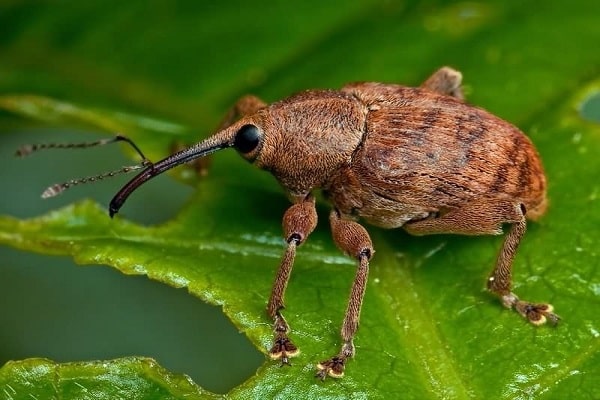
- digging the soil in the fall after harvesting;
- clearing the site from plant residues and weeds in the fall;
- it is recommended to plant onions in a new place annually.
If this insect appears on the beds, it is necessary to loosen the row spacing with the addition of tobacco dust, wood ash or ground pepper. If there are not too many pests, then you can collect them manually. Helps to destroy pests by spraying with a solution based on the drug Karbofos.

What is onion sick with?
Onions turn yellow not only because of the invasion of insect pests. Very often fungal, bacterial and viral infections can spoil the crop.
Rust
Rust is a fungal disease of onions. It affects green leaves, as a result, nutrients in an insufficient amount penetrate to the bulb, and the yield is reduced.

First, yellow-brown stripes or spots appear on the leaves, which grow over time. The disease leads to complete yellowing and drying of the green part of the onion.
Preventive measures mainly relate to planting material that needs to be warmed up and disinfected. If a problem is found, the onion beds are sprayed with a solution based on copper oxychloride. The component is diluted in a bucket of water and 30 ml of liquid soap is added. You can use the drug Hom or Metronidazole.
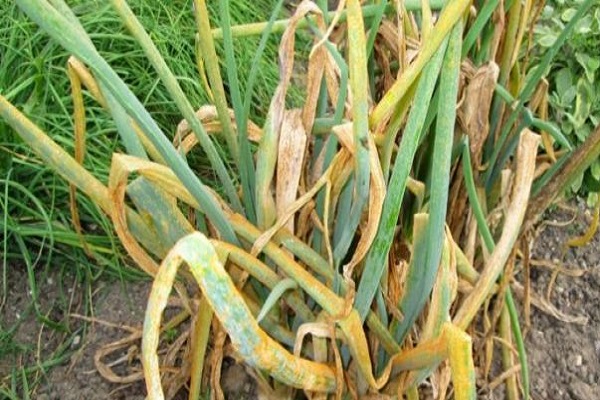
Bulb rot caused by bacteria
Bulb rot can only be seen on the harvested crop. The affected heads soften and dark stripes can be found between the scales. Such bulbs cannot be stored. This onion disease carried by insects.
Only healthy, dense bulbs are selected for planting. The soil is treated with Hom or Metronidazole. If you plant an affected set, then the plant grows weak. Young leaves immediately turn yellow and dry out.
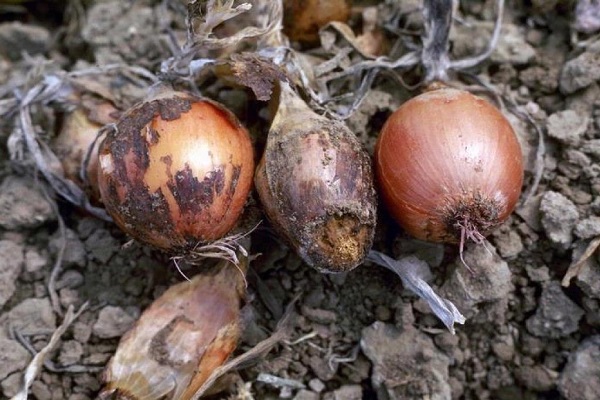
Fusarium blight, bottom rot
All varieties of onions can suffer from such a fungal disease as fusarium. First, onion feathers turn yellow, curl, and then dry out completely and the plant dies. On the bottom and in the axils of the leaves, you can see a white or light pink bloom.
The following actions can be used to prevent damage to the bottom by rot:
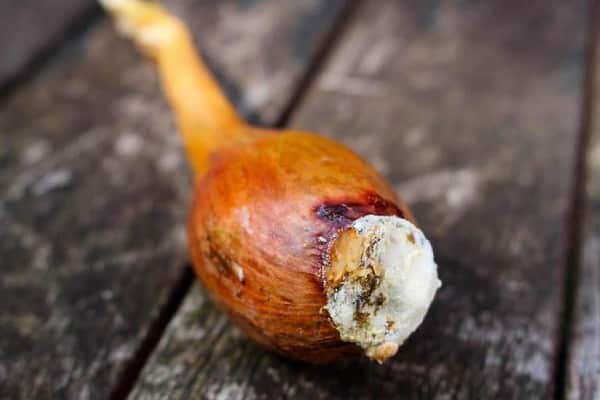
- the site for planting onions should be on a hill and well lit;
- you should not plant onions for several years in a row on the same plot; cereals are considered the best predecessors;
- you need to plant a vegetable and harvest on time;
- seeds are selected and disinfected before planting.
When the first signs of the disease appear, treatment with Fitosporin, Quadris will help.

Alternaria
Another fungal disease that affects onions is Alternaria. Green feathers are affected first. They form white spots that turn brown over time. Gradually, the disease passes to the bulb, it becomes covered with black mold and rots.
Such preparations as Acrobat, Cabrio Duo, Poliram, Fitosporin will help save the onion from yellowing of the feather. In the fall, after harvesting, all tops and husks are removed from the garden.
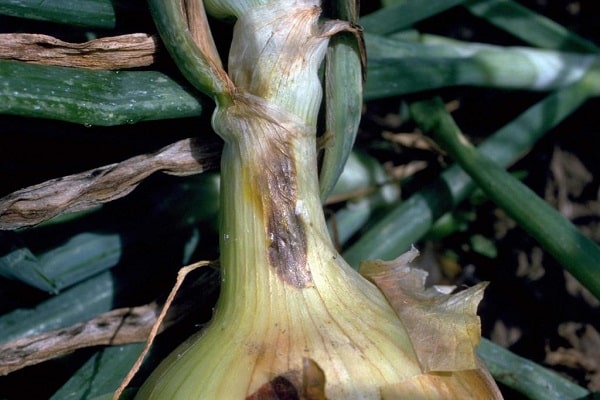
Failure to follow the rules of onion care leads to yellowing of the feather
If you take care of vegetable plantings incorrectly, then they become weak, lethargic and the leaves change color. Watering and feeding should be carried out in a timely manner and in certain quantities.

Insufficient or improper watering
When correct watering onion head is formed dense, juicy and stored for a long time. In the early days, when the onion is just taking root, water it abundantly every three days. Then watering is reduced to once a week. In July, when the head is being formed, watering is enough once every 1.5 weeks.
Water for irrigation should be warm (about 20 degrees) and it is better to pour it at the root. The best time to water is in the early morning or evening hours. If the weather is cloudy, then it is possible at lunchtime.

Onions love moist soil, but excess moisture can lead to stunted growth, due to leaching of micronutrients, rotting and the spread of infections. In addition, the onion head is small and tasteless.
Another reason why, under normal conditions of plant care, the leaves turn yellow, weather conditions become. Return frosts, droughts or heavy rains can affect the quality and quantity of the crop.

Lack of feeding
During watering, it is recommended to feed. The first fertilization is carried out two weeks after planting. You can make a solution from ammonium nitrate, superphosphate and potassium salt. The next feeding is carried out after another two weeks.
What to do?
There are many ways what to do if the onion turns yellow, dries and dies. The main thing is to recognize the cause in time.

Folk remedies for feather yellowing
If pests become the cause of the yellowing of the onion, then folk remedies will help:
- One ampoule of ammonia, 200 g of common table salt and 200 g of wood ash are dissolved in 10 liters of water. It is recommended to water the beds with the resulting solution after 10 days, until the leaves turn green again.
- 1 kg of soda, 10 ml of iodine and 4 bags of potassium permanganate are dissolved in a bucket of water. The finished concentrate is diluted with water in a 1: 1 ratio and the beds are watered. The solution is enough for a large planting area.
- Infusions of plants are prepared from dandelions, wormwood, calendula, and hot pepper.
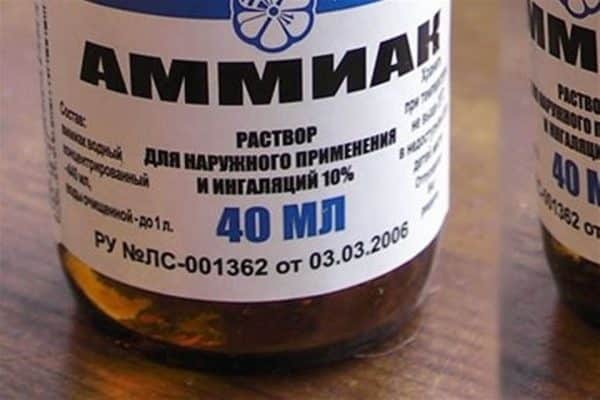
As a preventive measure, you can water the aisles with salt water or sprinkle with a dry mixture of tobacco dust, wood ash and ground pepper.
Plant protection chemicals
In the event of a massive attack of pests, due to which the onion has turned yellow, they are sprayed with chemicals. Among the popular and effective ones: Mostilan, Iskra, Aktara, Karbofos, Leptocid, Creocid.
To prevent the onion from turning yellow, it is possible to prevent the lack of nitrogen in the soil by adding urea or ammonium nitrate. Grooves are dug between the rows of onions and 6 grams of ammonium nitrate per 1 sq. m.
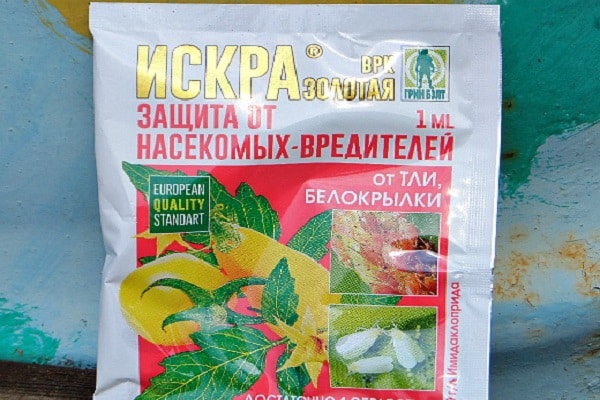
Simple tips for onion care
How to water the beds to effectively combat yellowing of the leaves? Most vegetable growers use salted water. A mixture of wood ash and carrot seed powder gives a good effect. You can treat the beds with wood ash or pollination of chamomile. If the onion turns yellow, then you can feed it with complex fertilizer.


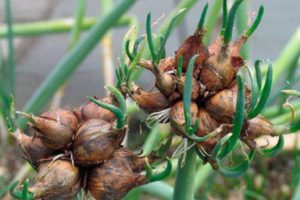

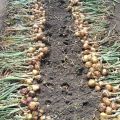
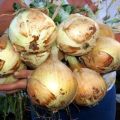


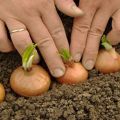
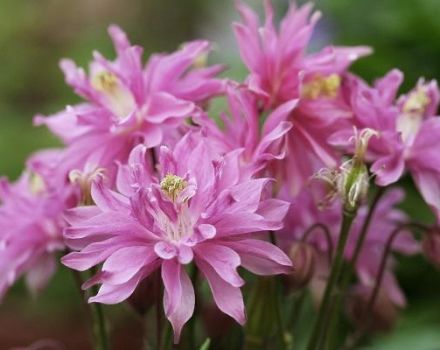
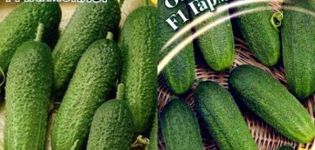
My onions turn yellow only when they do not get enough water and trace elements. I would recommend using the product BioGrow, it quickly solves such problems.